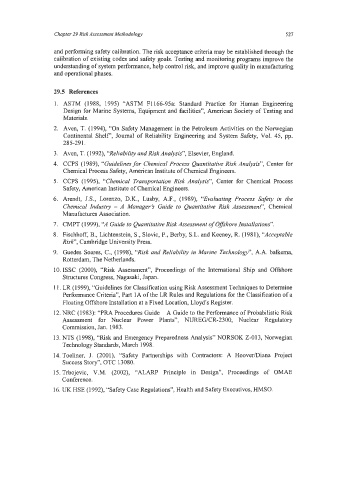Page 551 - Marine Structural Design
P. 551
Chapter 29 Risk Assessment Methodology 527
and performing safety calibration. The risk acceptance criteria may be established through the
calibration of existing codes and safety goals. Testing and monitoring programs improve the
understanding of system performance, help control risk, and improve quality in manufacturing
and operational phases.
29.5 References
1. ASTM (1988, 1995) “ASTM F1166-95a: Standard Practice for Human Engineering
Design for Marine Systems, Equipment and facilities”, American Society of Testing and
Materials.
2. Aven, T. (1994), “On Safety Management in the Petroleum Activities on the Norwegian
Continental Shelf”, Journal of Reliability Engineering and System Safety, Vol. 45, pp.
285-291.
3. Aven, T. (1992), “Reliability and Risk Analysis”, Elsevier, England.
4. CCPS (1989), “Guidelines for Chemical Process Quantitative Risk Analysis”, Center for
Chemical Process Safety, American Institute of Chemical Engineers.
5. CCPS (1 999, “Chemical Transportation Risk Analysis”, Center for Chemical Process
Safety, American Institute of Chemical Engineers.
6. Arendt, J.S., Lorenzo, D.K., Lusby, A.F., (1989), “Evaluating Process Safety in the
Chemical Industry - A Manager’s Guide to Quantitative Risk Assessment’’, Chemical
Manufactures Association.
7. CMPT (1999), “A Guide to Quantitative Risk Assessment of Ofshore Installations”.
8. Fischhoff, B., Lichtenstein, S., Slovic, P., Berby, S.L. and Keeney, R. (1981), “Acceptable
RisK‘, Cambridge University Press.
9. Guedes Soares, C., (1998), “Risk and Reliability in Marine Technology”, A.A. balkema,
Rotterdam, The Netherlands.
10. ISSC (2000), “Risk Assessment”, Proceedings of the International Ship and Offshore
Structures Congress, Nagasaki, Japan.
1 1. LR (1 999), “Guidelines for Classification using Risk Assessment Techniques to Determine
Performance Criteria”, Part 1A of the LR Rules and Regulations for the Classification of a
Floating Offshore Installation at a Fixed Location, Lloyd’s Register.
12. NRC (1983): “PRA Procedures Guide - A Guide to the Performance of Probabilistic Risk
Assessment for Nuclear Power Plants”, NUREG/CR-2300, Nuclear Regulatory
Commission, Jan. 1983.
13. NTS (1998), “Risk and Emergency Preparedness Analysis” NORSOK 2-013, Norwegian
Technology Standards, March 1998.
14. Toeliner, J. (2001), “Safety Partnerships with Contractors: A HooverDiana Project
Success Story”, OTC 13080.
15. Trbojevic, V.M. (2002), “ALARP Principle in Design”, Proceedings of O W
Conference.
16. UK HSE (1992), “Safety Case Regulations”, Health and Safety Executives, HMSO.

